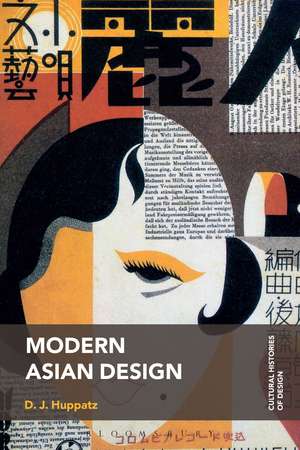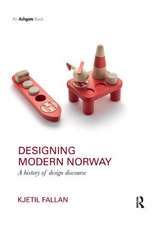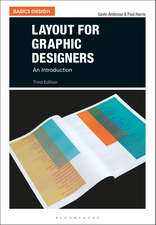Modern Asian Design: Cultural Histories of Design
Autor D.J. Huppatzen Limba Engleză Paperback – 21 feb 2018
| Toate formatele și edițiile | Preț | Express |
|---|---|---|
| Paperback (1) | 181.59 lei 22-36 zile | |
| Bloomsbury Publishing – 21 feb 2018 | 181.59 lei 22-36 zile | |
| Hardback (1) | 570.83 lei 43-57 zile | |
| Bloomsbury Publishing – 21 feb 2018 | 570.83 lei 43-57 zile |
Preț: 181.59 lei
Preț vechi: 209.34 lei
-13% Nou
Puncte Express: 272
Preț estimativ în valută:
34.76€ • 37.77$ • 29.22£
34.76€ • 37.77$ • 29.22£
Carte disponibilă
Livrare economică 31 martie-14 aprilie
Preluare comenzi: 021 569.72.76
Specificații
ISBN-13: 9781474296779
ISBN-10: 1474296777
Pagini: 272
Ilustrații: 24 b/w and 6 colour
Dimensiuni: 156 x 234 x 18 mm
Greutate: 0.49 kg
Editura: Bloomsbury Publishing
Colecția Bloomsbury Academic
Seria Cultural Histories of Design
Locul publicării:London, United Kingdom
ISBN-10: 1474296777
Pagini: 272
Ilustrații: 24 b/w and 6 colour
Dimensiuni: 156 x 234 x 18 mm
Greutate: 0.49 kg
Editura: Bloomsbury Publishing
Colecția Bloomsbury Academic
Seria Cultural Histories of Design
Locul publicării:London, United Kingdom
Caracteristici
Provides the first overview history of the development of modern design - as a profession and an industrial practice - in Asia
Notă biografică
D.J. Huppatz is Deputy Department Chair of Interior and Industrial Design at Swinburne University of Technology, Australia. He has edited the four volume Design: Critical and Primary Sources (2016), and has contributed chapters and articles to a number of journals and edited volumes, including the Bloomsbury Encyclopedia of Design (2015).
Cuprins
Introduction Chapter 1: Foundations, 1700-1850 - Part I: China from China - Part II: Textiles from India- Part III: Modernization, Globalization and DesignSECTION I: PATHS TO MODERNITY, 1850s-1930sChapter 2: Elite Paths - Part I: Meiji Japan: Designing a Modern State - Part II: Siam and Civilization- Part III: Modernizing Everyday Life in Tashio JapanChapter 3: Colonial Paths - Part I: Designing the British Raj- Part II: Designing an Asian EmpireChapter 4: Professional Paths - Part I: East Meets West- Part III: Shanghai Modernism- Part II: West Meets EastChapter 5: Consumer Paths - Part I: The Herald of Civilization- Part II: New Patent Medicines- Part III: The Department StoreSECTION II: ASIAN MODERNITY, 1940s-2000sChapter 6: Postcolonial Design and the State - Part I: Chandigarh- Part II: Designing the People's Republic of China- Part III: Singapore Chapter 7: Design and Development - Part I: From Domestic Appliances to Digital Lifestyles- Part II: Design for DevelopmentChapter 8: The Design Professional - Part I: Kenji Ekuan- Part II: Minnette de Silva- Part III: Kan Tai-Keung Chapter 9: Globalization and Consuming Asian Design - Part I: Rebranding banks in Hong Kong - Part II: Asian lifestyle brandsConclusion
Recenzii
Huppatz's book is a welcome addition to a growing field . [It] is hoped that viewpoints and writings on AsianDesign will multiply in the coming years to create a more robust and inclusive global design history landscape.
Modern Asian Design is a rich and timely contribution to the emergent body of research on design histories beyond the West. The book expands our knowledge of modern design in Asia and provides methodological approaches to studying what are often viewed as marginal contexts in design history.
Modern Asian Design is a rich and timely contribution to the emergent body of research on design histories beyond the West. The book expands our knowledge of modern design in Asia and provides methodological approaches to studying what are often viewed as marginal contexts in design history.




























